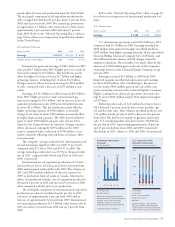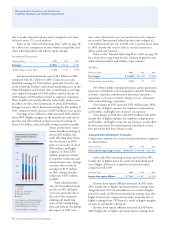Chevron 2011 Annual Report Download - page 25
Download and view the complete annual report
Please find page 25 of the 2011 Chevron annual report below. You can navigate through the pages in the report by either clicking on the pages listed below, or by using the keyword search tool below to find specific information within the annual report.Chevron Corporation 2011 Annual Report 23
Of the remaining year-end 2011 environmental
reserves balance of $1,219 million, $675 million related
to the company’s U.S. downstream operations, including
reneries andother plants, marketing locations (i.e., service
stations and terminals), chemical facilities, and pipelines.
e remaining $544 million was associated with various
sites in international downstream ($95 million), upstream
($368 mil lion) and other businesses ($81 million). Liabilities
at all sites, whether operating, closed or divested, were pri-
marily associated with the company’s plans and activities
to remediate soil or groundwater contamination or both.
ese and other activities include one or more of the
following: site assessment; soil excavation; osite disposal
of contaminants; onsite containment, remediation and/
or extraction of petroleum hydrocarbon liquid and vapor
from soil; groundwater extraction and treatment; and
monitoring of the natural attenuation of the contaminants.
e company manages environmental liabilities under
specic sets of regulatory requirements, which in the United
States include the Resource Conservation and Recovery Act
and various state and local regulations. No single remediation
site at year-end 2011 had a recorded liability that was mate-
rial to the company’s results of operations, consolidated
nancial position or liquidity.
It is likely that the company will continue to incur addi-
tional liabilities, beyond those recorded, for environmental
remediation relating to past operations. ese future costs are
not fully determinable due to such factors as the unknown
magnitude of possible contamination, the unknown timing
and extent of the corrective actions that may be required,
the determination of the company’s liability in proportion to
other responsible parties, and the extent to which such costs
are recoverable from third parties.
e company records asset retirement obligations when
there is a legal obligation associated with the retirement of
long-lived assets and the liability can be reasonably estimated.
ese asset retirement obligations include costs related to
environmental issues. e liability balance of approximately
$12.8 billion for asset retirement obligations at year-end 2011
related primarily to upstream properties.
For the company’s other ongoing operating assets, such as
reneries and chemicals facilities, no provisions are made for
exit or cleanup costs that may be required when such assets
reach the end of their useful lives unless a decision to sell or
otherwise abandon the facility has been made, as the inde-
terminate settlement dates for the asset retirements prevent
estimation of the fair value of the asset retirement obligation.
Refer also to Note 25 on page 66, related to the
company’s asset retirement obligations and the discussion
of“Environmental Matters” beginning on page 23.
Suspended Wells e company suspends the costs of
exploratory wells pending a nal determination of the com-
mercial potential of the related crude oil and natural gas
elds. e ultimate disposition of these well costs is depen-
dent on the results of future drilling activity or development
decisions or both. At December 31, 2011, the company had
approximately $2.4 billion of suspended exploratory wells
included in properties, plant and equipment, a decrease
of $284 million from 2010. e 2010 balance reected
anincrease of $283 million from 2009.
e future trend of the company’s exploration expenses
can be aected by amounts associated with well write-os,
including wells that had been previously suspended pend-
ing determination as to whether the well had found reserves
that could be classied as proved. e eect on exploration
expenses in future periods of the $2.4 billion of suspended
wells at year-end 2011 is uncertain pending future activities,
including normal project evaluation and additional drilling.
Refer to Note 19, beginning on page 55, for addi -
tional discussion of suspended wells.
Income Taxes Information related to income tax contin-
gencies is included on pages 51 through 53 in Note 15 and
page 64 in Note 24 to the Consolidated Financial Statements
under the heading “Income Taxes.”
Other Contingencies Information related to other contin-
gencies is included on pages 65 through 66 in Note 24 to the
Consolidated Financial Statements under the heading “Other
Contingencies.”
Environmental Matters
Virtually all aspects of the businesses in which the company
engages are subject to various federal, state and local envi-
ronmental, health and safety laws and regulations. ese
regulatory requirements continue to increase in both number
and complexity over time and govern not only the manner
in which the company conducts its operations, but also the
products it sells. Most of the costs of complying with laws
and regulations pertaining to company operations and prod-
ucts are embedded in the normal costs of doing business.
Accidental leaks and spills requiring cleanup may occur
in the ordinary course of business. In addition to the costs
for environmental protection associated with its ongoing
operations and products, the company may incur expenses
for corrective actions at various owned and previously owned
facilities and at third-party-owned waste disposal sites used
by the company. An obligation may arise when operations are
closed or sold or at non-Chevron sites where company products
have been handled or disposed of. Most of the expenditures to
fulll these obligations relate to facilities and sites where past
operations followed practices and procedures that were con-
sidered acceptable at the time but now require investigative or
remedial work or both to meet current standards.
Using denitions and guidelines established by the
American Petroleum Institute, Chevron estimated its worldwide
environmental spending in 2011 at approximately $2.7 billion
for its consolidated companies. Included in these expenditures
were approximately $1.0 billion of environmental capital
expenditures and $1.7 billion of costs associated with the
prevention, control, abatement or elimination of hazardous
substances and pollutants from operating, closed or divested
sites, and the abandonment and restoration of sites.
For 2012, total worldwide environmental capital expen-
ditures are estimated at $1.0 billion. ese capital costs are
in addition to the ongoing costs of complying with envi-
ronmental regulations and the costs to remediate previously
contaminated sites.
























